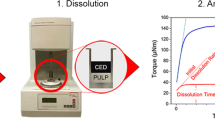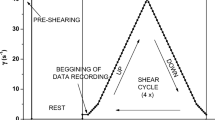Abstract
The rheological behavior of low consistency thermomechanical pulp of Chinese fir harvested by intermediate thinning was analyzed. The results show that the apparent viscosity of pulp changed along with the beating degree, pulp consistency and shearing velocity. With the increasing of pulp consistency, the apparent viscosity of pulp increased gradually. Beating degree of pulp had an effect on micro-structure of pulp. The apparent viscosity of pulp declined as beating degree of pulp increased, and the apparent viscosity of pulp fell along with the shearing velocity increasing. Based on the results, the rheological models are set up. The models showed that the fluid types of the low consistency pulp could be described as pseudoplastics fluids (non-Newtonian fluids).
Similar content being viewed by others
References
Carson, L.C. and Sun, XS. 2000. Breads from white grain sorghum: Rheological properties and baking volume with exogenous gluten protein [J]. Applied Engineering in Agriculture, 16(4): 423–429
Cha, J.Y, Chung, D.S., Seib, P.A. 1999. Rheological properties of blend melts for starch-based foams in extrusion processing [J]. Transaction of ASAE, 42(6): 1801–1808
Chai Chunxiang, Zhao Jiewen, Qiu Baijing. 2000. Study on relationship between microstructure of minced fish and its rheological properties [J]. Transaction of CSAE, 16(3): 15–18. (in Chinese)
Chen Kefu. 1992. Hydrodynamics application on pulp and paper research [J]. Mechanics and Practice, 14(6): 7–15. (in Chinese)
Fu Pingle, Chen Kefu, Liu Huanbing. 1999. Numerical model on the jet flow of pulp suspension [J]. Journal of Guangxi University (Natural Science Edition), 24(1): 45–48. (in Chinese)
Han Hongsheng, Cui Haiqing, Zhao Renbao. 1993. Survey and regression of rheology parameters for non-Newtonian fluids [J]. Journal of Daqing Petroleum Institute, 17(3): 19–25. (in Chinese)
Landry, H., Lagu, C., Roberge, M. 2004. Physical and rheological properties of manure products [J]. Applied Engineering in Agriculture, 20(3): 277–288
Li Huabei and Zhai Jiewen. 2001. Experimental study on rheological properties of mined food materials [J]. Food Science, 22(3): 17–19. (in Chinese)
Miao Zonghua, Huang Zutai, Chen Lihui, et al. 1999. Study on the equipment design and technology of environment friendly tableware made from plant fiber [J]. Forestry Machinery and Woodworking Equipment, 27(11): 10–12. (in Chinese)
Michele M, Hoshahili A R T, Ramaswamy H S. 2001. Rheological properties of selected hydrocolloids as a function of concentration and temperature. Food Research International, 34: 695–703
Qiu Renhui, Wang Keqi, Huang Zutai, et al. 2002. Design of barometric transmission system of pulp molding produce line [J]. Forestry Machinery and Woodworking Equipment, 30(6): 4–7 (in Chinese)
Togrul, H. and Arslan, N. 2004. Mathematical model for prediction of apparent viscosity of molasses [J]. Journal of Food Engineering, 62: 281–289
Velez-Ruiz, J.F. and Barbosa-canovas, G.V. 1998. Rheological properties of concentrated milk as a function of concentration, temperature and storage time [J]. Journal of Food Engineering, 35: 177–190.
Wang Keqi, Qiu Renhui, Huang Zutai, et al. 2003. The technical parameters of molding of tableware made from mechanical pulp of Chinese fir [J]. Journal of Northeast Forestry University, 31(2): 6–8. (in Chinese)
Zaman, A. 1995. Effects of pulping condition and black liquor on viscosity of softwood craft black liquors: Predictive models [J]. Tappi, 78(10): 107–119
Zaman, A. 1996. Effect of pulping condition and black liquor composition on Newtonian viscosity of high solids craft black liquors [J]. Industrial of Engineering Chemistry Research, 35(2):590–597.
Author information
Authors and Affiliations
Corresponding author
Additional information
Foundation items: This study was sponsored by the Research Funding for Outstanding Young University Faculty of China Ministry of Education (No. 2001-39), Fujian Provincial Innovation Fundation for Young Science and Technology Talents (No. 2004J012), and the National Natural Science Fundation of China (No. 30571461).
Biography: QIU Ren-Hui (1968–), male, Associate Professor of Fujian Agriculture and Forestry University, Fuzhou 350002, P.R. China.
Rights and permissions
About this article
Cite this article
Qiu, Rh., Wang, Kq. & Huang, Zt. Rheological properties of low consistency TMP from thinning wood of Chinese fir. J. of For. Res. 17, 145–149 (2006). https://doi.org/10.1007/s11676-006-0034-0
Received:
Accepted:
Issue Date:
DOI: https://doi.org/10.1007/s11676-006-0034-0
Keywords
- Thermomechanical pulp
- Chinese Fir
- Thinning wood
- Low consistency pulp
- Rheological properties
- Pseudoplastics fluid




